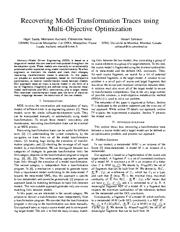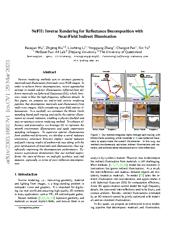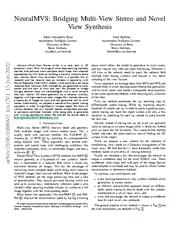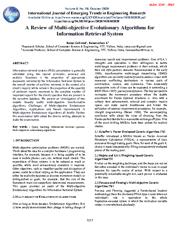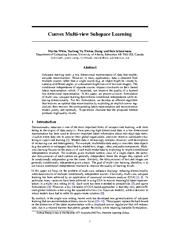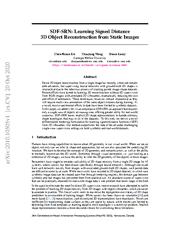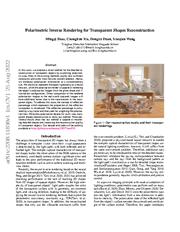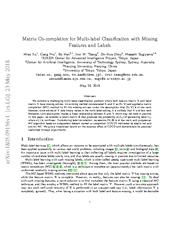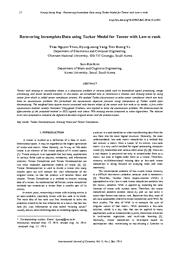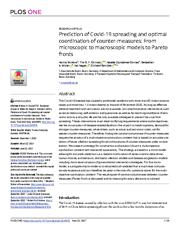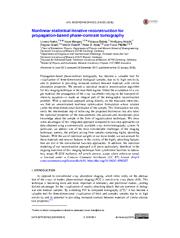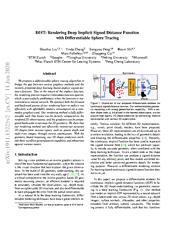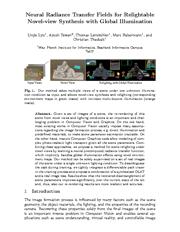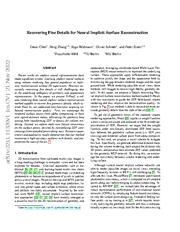A copy of this work was available on the public web and has been preserved in the Wayback Machine. The capture dates from 2017; you can also visit the original URL.
The file type is application/pdf.
Filters
Recovering model transformation traces using multi-objective optimization
2013
2013 28th IEEE/ACM International Conference on Automated Software Engineering (ASE)
In this paper, we propose an automated approach, based on multi-objective optimization, to recover transformation traces between models. ...
To allow engineers to maintain the models and track their changes, recovering transformation traces is essential. ...
Thus, the trace recovery can be seen as a multi-objective optimization problem. ...
doi:10.1109/ase.2013.6693134
dblp:conf/kbse/SaadaHNS13
fatcat:t6ywjr3zijf4fky6yye4iiawam
A Novel Multi-Objective Electromagnetic Analysis Based on Genetic Algorithm
2019
Sensors
Multi-objective optimization is a good way to solve the problem of a single byte of the key. ...
Combining the advantages of multi-objective optimization and genetic algorithm, we put forward a novel multi-objective electromagnetic analysis based on a genetic algorithm to take full advantage of information ...
It usually can be divided into two parts: one is to reconstruct a new objective function to convert a multi-objective optimization problem into a single-objective optimization problem; another is to transform ...
doi:10.3390/s19245542
pmid:31847445
pmcid:PMC6960805
fatcat:dsrkzyyhfjeatnf5iekfywfmey
NeFII: Inverse Rendering for Reflectance Decomposition with Near-Field Indirect Illumination
[article]
2023
arXiv
pre-print
In a nutshell, we introduce the Monte Carlo sampling based path tracing and cache the indirect illumination as neural radiance, enabling a physics-faithful and easy-to-optimize inverse rendering method ...
Inverse rendering methods aim to estimate geometry, materials and illumination from multi-view RGB images. ...
We use the simplified Disney BRDF model [8] with parameters including roughness, diffuse albedo and specular albedo. ...
arXiv:2303.16617v2
fatcat:yp3yudresbhflp2apjf354ao7y
NeuralMVS: Bridging Multi-View Stereo and Novel View Synthesis
[article]
2022
arXiv
pre-print
Novel View Synthesis (NVS) is a parallel line of research and has recently seen an increase in popularity with Neural Radiance Field (NeRF) models, which optimize a per scene radiance field. ...
Multi-View Stereo (MVS) is a core task in 3D computer vision. ...
The model didn't use any per-scene optimization and was trained only on the training set of DTU showing that it can generalize to novel views and novel objects.
Fig. 8 . 8 Fig.8. ...
arXiv:2108.03880v2
fatcat:smedf5lpmvfknd47vqilgqppau
A Review of Multi-objective Evolutionary Algorithms for Information Retrieval System
2020
International Journal of Emerging Trends in Engineering Research
We present an investigation of two notable broadly useful multi-objective transformative algorithms, Challenges of Multi-objective Evolutionary Algorithms, Applications and Recent improvements in Multi-objective ...
Information retrieval systems (IRSs) presentation is generally calculated using two special principles, accuracy and analysis. ...
A Review of Multi-objective Evolutionary Algorithms for Information Retrieval System ...
doi:10.30534/ijeter/2020/1458102020
fatcat:qme6cftpv5eilpez7bqerc6ixy
Convex Multi-view Subspace Learning
2012
Neural Information Processing Systems
and reconstruction model, jointly and optimally. ...
For this formulation, we develop an efficient algorithm that recovers an optimal data reconstruction by exploiting an implicit convex regularizer, then recovers the corresponding latent representation ...
Our strategy will be to first recover the optimal dual solution Γ given Ẑ, then use Γ to recover H and C. First, to recover Γ one can simply trace back from (21) to (20) . ...
dblp:conf/nips/WhiteYZS12
fatcat:cucctt3iuneg3lqvo2sphwoxkm
SDF-SRN: Learning Signed Distance 3D Object Reconstruction from Static Images
[article]
2020
arXiv
pre-print
These techniques, however, remain impractical as they still require multi-view annotations of the same object instance during training. ...
Dense 3D object reconstruction from a single image has recently witnessed remarkable advances, but supervising neural networks with ground-truth 3D shapes is impractical due to the laborious process of ...
In particular, we center the object and rescale such that 1. We use the ground-truth CAD model and camera pose associated with each image to create the object silhouettes. ...
arXiv:2010.10505v1
fatcat:ucowbzjzt5anbjqwkpk7xw3ufu
Polarimetric Inverse Rendering for Transparent Shapes Reconstruction
[article]
2022
arXiv
pre-print
The experimental results show that our method is capable of recovering detailed shapes and improving the reconstruction quality of transparent objects. ...
We build a polarization dataset for multi-view transparent shapes reconstruction to verify our method. ...
The model is trained on a RTX 3090 GPU(24GB). We use the Adam optimizer (Kingma and Ba 2014) with a learning rate of 1e − 4 to optimize the network. ...
arXiv:2208.11836v1
fatcat:fjf4e7l7xfflbp2lndtgsuiygi
Matrix Co-completion for Multi-label Classification with Missing Features and Labels
[article]
2018
arXiv
pre-print
We give a theoretical bound on the recovery effect of COCO and demonstrate its practical usefulness through experiments. ...
However, since entries of take binary values in the multi-label setting, it is unlikely that is of low-rank. ...
Motivated by the advantage of the elastic net [17] which uses both the L1 norm and L2 norm for regularization, we additionally consider optimizing the trace norm of the difference between the recovered ...
arXiv:1805.09156v1
fatcat:s2tjqgeny5bh3daxm5y5adf25a
Recovering Incomplete Data using Tucker Model for Tensor with Low-n-rank
2016
International Journal of Contents
We formulated the optimization objective function using components of Tucker model after decomposing. ...
A first order optimization method, namely Nonlinear Conjugated Gradient, was applied to solve the optimization problem. ...
Therefore, trace norm is used to approximate rank of matrices, aims to relax the object function to convex optimization problem. ...
doi:10.5392/ijoc.2016.12.3.022
fatcat:7bnx5zkcobd7jax2jovecg67xu
Prediction of Covid-19 spreading and optimal coordination of counter-measures: From microscopic to macroscopic models to Pareto fronts
2021
PLoS ONE
For this micro-model, a surrogate macro-model is constructed and validated that is much less computationally expensive and can therefore be used in the core of a numerical solver for the multi-objective ...
We present a strategy for construction and solution of such a multi-objective optimization problem with real-world applicability. ...
Acknowledgments We thank Michael Wulkow for his collaboration on the ODE model and its parametrization using PREDICI, and Michael Dellnitz for joint discussions regarding the Pareto front and its numerical ...
doi:10.1371/journal.pone.0249676
pmid:33887760
pmcid:PMC8062158
fatcat:nvrskbouhbg3hae2ysk7e7a5ea
Nonlinear statistical iterative reconstruction for propagation-based phase-contrast tomography
2018
APL Bioengineering
With the use of statistical weights in our noise model, we can account for these materials and recover features in the vicinity of the highly absorbing features that are lost in the conventional two-step ...
With a statistical approach acting directly on the measured intensities, we find an unconstrained nonlinear optimization formulation whose solution yields the three-dimensional distribution of the sample ...
If as a special case we assume a non-absorbing object l i ¼ 0 and recover the phase from its trace, namely, / i ¼ ÀkdT i , we are left with a forward model whose analytical solution coincides with the ...
doi:10.1063/1.4990387
pmid:31069290
pmcid:PMC6481703
fatcat:you573dl5rbzlldaqvtpnmpmsa
DIST: Rendering Deep Implicit Signed Distance Function with Differentiable Sphere Tracing
[article]
2020
arXiv
pre-print
We show that our rendering method can effectively reconstruct accurate 3D shapes from various inputs, such as sparse depth and multi-view images, through inverse optimization. ...
We propose a differentiable sphere tracing algorithm to bridge the gap between inverse graphics methods and the recently proposed deep learning based implicit signed distance function. ...
We take a pre-trained DeepSDF [35] model and run geometry based optimization to recover the 3D shape and camera extrinsics separately using our differentiable renderer. ...
arXiv:1911.13225v2
fatcat:rskpvvh7yrbyzhixlg744emk3m
Neural Radiance Transfer Fields for Relightable Novel-view Synthesis with Global Illumination
[article]
2022
arXiv
pre-print
On the other hand, mature Computer Graphics tools allow modeling of complex photo-realistic light transport given all the scene parameters. ...
Results show that the recovered disentanglement of scene parameters improves significantly over the current state of the art and, thus, also our re-rendering results are more realistic and accurate. ...
Methods have explored different ways of modeling indirect illumination using path tracing. ...
arXiv:2207.13607v1
fatcat:bktow7ydnjhftimswdmwwtplna
Recovering Fine Details for Neural Implicit Surface Reconstruction
[article]
2022
arXiv
pre-print
Learning implicit neural surfaces using volume rendering has gained popularity in multi-view reconstruction without 3D supervision. ...
However, accurately recovering fine details is still challenging, due to the underlying ambiguity of geometry and appearance representation. ...
In surface rendering-based neural reconstruction [33, 37] , differentiable ray tracing is commonly used to find the intersection point between a camera ray and object surface. ...
arXiv:2211.11320v1
fatcat:juqvz5w7w5bzdp3uqcpgk77esa
« Previous
Showing results 1 — 15 out of 58,503 results

